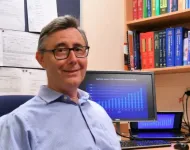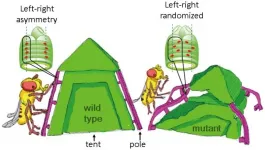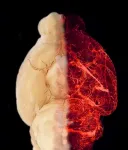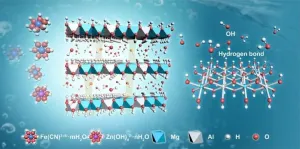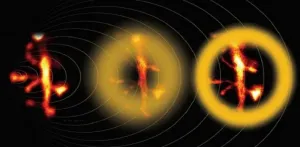(Press-News.org) Researchers from The Australian National University (ANU) have developed new technology that allows people to see clearly in the dark, revolutionising night-vision.
The first-of-its-kind thin film, described in a new article published in Advanced Photonics, is ultra-compact and one day could work on standard glasses.
The researchers say the new prototype tech, based on nanoscale crystals, could be used for defence, as well as making it safer to drive at night and walking home after dark.
The team also say the work of police and security guards - who regularly employ night vision - will be easier and safer, reducing chronic neck injuries from currently bulk night-vision devices.
"We have made the invisible visible," lead researcher Dr Rocio Camacho Morales said.
"Our technology is able to transform infrared light, normally invisible to the human eye, and turn this into images people can clearly see - even at distance.
"We've made a very thin film, consisting of nanometre-scale crystals, hundreds of times thinner than a human hair, that can be directly applied to glasses and acts as a filter, allowing you to see in the darkness of the night."
The technology is extremely lightweight, cheap and easy to mass produce, making them accessible to everyday users.
Currently, high-end infrared imaging tech requires cryogenic freezing to work and are costly to produce. This new tech works at room temperatures.
Dragomir Neshev, Director of the ARC Centre for Excellence in Transformative Meta-Optical Systems (TMOS) and ANU Professor in Physics, said the new tech used meta-surfaces, or thin films, to manipulate light in new ways.
"This is the first time anywhere in the world that infrared light has been successfully transformed into visible images in an ultra-thin screen," Professor Neshev said.
"It's a really exciting development and one that we know will change the landscape for night vision forever."
The new tech has been developed by an international team of researchers from TMOS, ANU, Nottingham Trent University, UNSW and European partners.
Mohsen Rahmani, the Leader of the Advanced Optics and Photonics Lab in Nottingham Trent University's School of Science and Technology, led the development of the nanoscale crystal films.
"We previously demonstrated the potential of individual nanoscale crystals, but to exploit them in our everyday life we had to overcome enormous challenges to arrange the crystals in an array fashion," he said.
"While this is the first proof-of-concept experiment, we are actively working to further advance the technology."
INFORMATION:
Read about the breakthrough in Advanced Photonics.
Images available at:
https://anuphotos.photoshelter.com/galleries/C0000K1YRAhoAupw/G000025ze908a7Mc/Let-there-be-light
To arrange interviews, contact James Giggacher on +61 436 803 488 or ANU Media on +61 2 6125 7979 or media@anu.edu.au
Data collected for over two decades shows that rising Baltic Sea water temperature is one of the main factors in the increasingly earlier appearance and faster growth of Baltic herring larvae.
Baltic herring (Clupea harengus membras) is commercially the most important fish species in Finland, and an important part of the Baltic marine ecosystem. Conditions during herring spawning may have cascading effects on the whole Baltic ecosystem.
According to a recent research, both developmental stages in Baltic herring larvae, small and large, have shifted their timing to earlier dates.
"This suggests that herring spawn earlier and larvae grow faster, by about 7.7 days per decade. Water ...
Rising numbers of liver cancer in Aboriginal and Torres Strait Islander communities has led experts at Flinders University to call for more programs, including mobile liver clinics and ultrasound in rural and remote Australia.
The Australian study just published in international Lancet journal EClinicalMedicine reveals the survival difference was largely accounted for by factors other than Indigenous status - including rurality, comorbidity burden and lack of curative therapy.
The study of liver cancer, or Hepatocellular carcinoma (HCC), included 229 Indigenous and 3587 non-Indigenous HCC cases in South Australia, Queensland and the ...
Osaka, Japan - On the outside, animals often appear bilaterally symmetrical with mirror-image left and right features. However, this balance is not always reflected internally, as several organs such as the lungs and intestines are left-right (LR) asymmetrical. Researchers at Osaka University, using an innovative technique for imaging movement of cell nuclei in living tissue, have determined the patterns of nuclear alignment responsible for LR-asymmetrical shaping of internal organs in the developing embryo.
Embryogenesis involves complex genetic and molecular processes that transform a single-celled zygote into a complete, living individual with multiple functional axes, including the LR axis. A long-standing conundrum of Developmental ...
Researchers at the University of Helsinki and the Beatson Institute for Cancer Research in Glasgow have discovered how mutated cells promote their chances to form cancer. Typically, the accumulation of harmful cells is prevented by active competition between multiple stem cells in intestinal glands, called crypts.
"The functioning of intestinal stem cells relies on growth factors, named Wnts, produced by the surrounding environment. Intestinal cancers typically originate from stem cells where mutations allow growth independent of these factors. When we removed a gene called Notum, which renders Wnts inactive, from mutated stem cells, the number of precancerous adenomas in the intestine was greatly reduced. We found that ...
Echoing through history by reviving fungal specimens originally preserved and described a flabbergasting quarter of a millenium ago by the "Father of Modern Taxonomy" Carl Linnaeus, this study highlights the untapped potential of museum collections in modern research programmes. The results have just been published in the renowned Cell Press journal iScience.
The "desert coprinus" fungus Podaxis has fascinated scientists and explorers for centuries, still the genus has been subjected to relatively little research. These large mushrooms thrive in hostile and mostly species-free environments and while they occur seasonally ...
Hypertension is a widespread comorbidity of patients with obesity that greatly increases the risk of mortality and disability. In recent years, researchers have found that a high-calorie diet increases the density of blood vessels (hypervascularization) in the hypothalamus - an important "eating control" area in our brain. Researchers hypothesized that elevated hormone levels of leptin are associated with a higher risk of developing hypertension. However, the exact mechanisms that contribute to the condensed growth of blood vessels in the hypothalamus were unknown.
New research conducted by Cristina García-Cáceres' research group at Helmholtz Zentrum ...
Solar activities, such as CME(Coronal Mass Ejection), cause geomagnetic storm that is a temporary disturbance of the Earth's magnetosphere. Geomagnetic storms can affect GPS positioning, radio communication, and power transmission system. Solar explosions also emit radiation, which can affect satellite failures, radiation exposure to aircraft crew, and space activity. Therefore, it is important to understand space weather phenomena and their impact on the Earth.
Space weather research by continuous observation of cosmic rays on the ground is mainly conducted using observation data from neutron monitors and multi-directional muon detectors. Since the phenomenon of space weather is on a short-term, days-long scale, it is effective to investigate changes in the flow ...
Alkaline zinc-iron flow battery (AZIFB) is well suitable for stationary energy storage applications due to its advantages of high open-cell voltage, low cost, and environmental friendliness. However, it surfers from zinc dendrite/accumulation and relatively low operation current density.
Recently, a research group led by Prof. LI Xianfeng from the Dalian Institute of Chemical Physics (DICP) of the Chinese Academy of Science (CAS) developed layered double hydroxide (LDH) membrane with high hydroxide conductivity and ion selectivity for alkaline-zinc iron flow battery.
The ...
Light--and all waves--can bend around the corners of obstacles found along its path. Because of this phenomenon, called diffraction, it is impossible to focus light onto a spot that is smaller than half its wavelength. In other words, the highest resolution one can theoretically achieve using an optical microscope is approximately 250 nm, a barrier called the diffraction limit. Unfortunately, this resolution is not enough for observing fine cellular structures, such as those found in neurons.
Over more than a century, microscopists were hamstrung by this classic barrier until the invention of super-resolution fluorescence microscopy. One particularly powerful ...
Researchers have identified two subgroups of adolescents who self-harm and have shown that it is possible to predict those individuals at greatest risk almost a decade before they begin self-harming.
The team, based at the MRC Cognition and Brain Sciences Unit, University of Cambridge, found that while sleep problems and low self-esteem were common risk factors, there were two distinct profiles of young people who self-harm - one with emotional and behavioural difficulties and a second group without those difficulties, but with different risk factors.
Between one in five and one in seven adolescents in England self-harms, for example by deliberately cutting themselves. While self-harm is a significant risk factor for subsequent suicide attempts, many do not intend suicide but face ...

